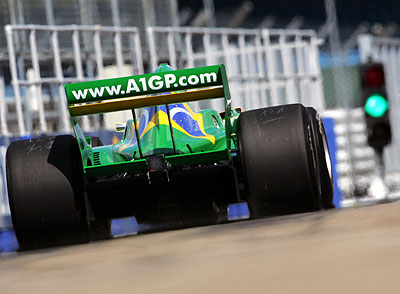


06/08/2005
NEWS STORY
 |
The organizers of the forthcoming A1 GP series have always stressed that the onus is on entertainment, indeed it was South Africa franchise holder, Tokyo Sexwale, talking at the launch of the UK team in September 2004, that came up with the term 'Motortainment'.
Just six weeks away from the inaugural race, A1 Grand Prix General Manager, Stephen Watson, talked to Pitpass about the weekend format, and the two main priorities for the series, entertaining the fans at the track, and entertaining those watching on TV.
He began by explaining the qualifying format.
Basically, the entire qualifying session, which takes place on Saturday, will last for two hours. However, it will be broken up into 'bite size' chunks, in order to keep the momentum going, but also to allowing TV adverts without disrupting live coverage.
The qualifying coverage will begin at 14:00, and following a brief introduction including interviews with drivers and team bosses, the cars will take part in a 15 minute session in which every team will complete just one run, consisting of an out lap, a flying lap, and then an in lap.
At the end of the 15-minute session, there will be a 10-minute break during which time fans at home and at the circuit will be brought up to date with what's been happening, who is fastest, and so on. During this break TV broadcasters will run their adverts in order that fans enjoy uninterrupted coverage of the track action.
As an example of A1 GP's 'attention to detail', Stephen points out; "there is nothing more frustrating than being at a track trying to hear the commentator read out the times, only to be drowned out by an engine". Therefore, the break will allow all the cars to return to the pits before the commentator gives out the crucial information.
Then there will be another fifteen minute session, followed by another 'break, and this will continue until there have been four 15-minute sessions in total.
The driver's two quickest times will then be aggregated, and these times will form the starting position for the sprint race.
"When we sat down to try and come up with a format, we knew exactly what we didn't want," says Stephen. "We didn't want formats that haven't proved popular before, in addition we were looking for an action packed session for the fans with 25 cars continuously pushing, trying to out-do one another.
"We've seen what happens in Formula One, where fans only get to see the drivers complete one run. We've also seen the old format, where nothing happens for the first twenty-five minutes, and then it goes crazy in the last five, making it almost impossible for fans to follow what's going on.
"Therefore, we've come up with this format."
Before we can interrupt, he continues: "I know what you're going to say, indeed a couple of journalists have already said it, that the format looks complicated. However, it's not.
"During the break at the end of each 10-minute session, fans (at home and at the track) will be brought fully up to date with the times. At the end of the second session they will know, almost instantly, what the aggregate times are, they'll know where their country stands in relation to the opposition.
"It really is very simple, and the computers will give the aggregate times almost instantly, so fans will know exactly what's happening."
We ask whether the weather could play a part, could teams opt to miss a session and settle for a time they've already 'banked'. Could we see strategic gamesmanship as witnessed in F1?
"Nobody will be forced to go out in every session," he replies, "however, more likely than not sitting out a session will not be beneficial.
"There are twenty-five cars going out in each 15-minute session, and teams will have to think on their feet, judge exactly when the time is right to go out. With that amount of traffic, drivers will have to overtake, they will have to be aggressive and deal with traffic.
"If the worst should happen and there is a heavy storm, or an accident, we might cancel one of the sessions, we might cancel two or even three. In which case the 'grid' for the sprint race will be based on the times from the sole session that has been run."
Its pointed out that only last week, Bernie Ecclestone told Pitpass editor, Chris Balfe, that he was looking to change the Formula One qualifying format because what the fans want to see is lots of cars doing lots of laps, not one car at a time.
"Exactly," says Stephen. "We sat down and took a long hard look at this, it wasn't a decision that we made overnight. The prime motivation is entertainment, for the fans, at home watching on TV, and those that have paid at the gate.
"However, we also have to think about sponsors, they won't be happy seeing their logo on a car that makes just one run."
To summarise, the aggregate of the best two times posted in qualifying, will decide the starting order (grid) for the sprint race which takes place on Sunday.
The finishing order of the sprint race, which features a 'rolling start', will decide the starting grid for the main race, which includes a mandatory pit stop.
The weekend format is fairly straightforward, featuring two one-hour practice sessions on Friday, a further practice session on Saturday, followed by qualifying, while Sunday will kick-off with a fifteen minute warm up in the morning, followed by the two races.